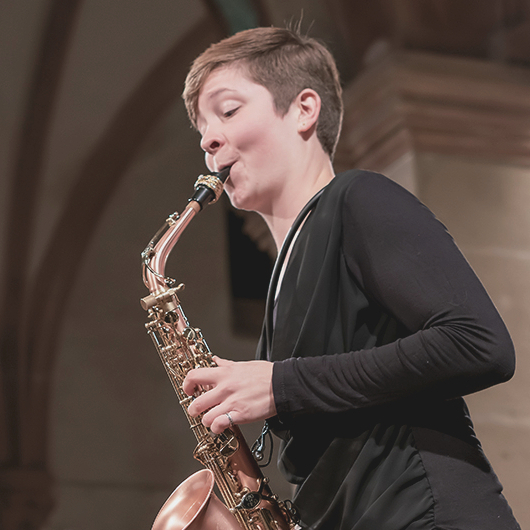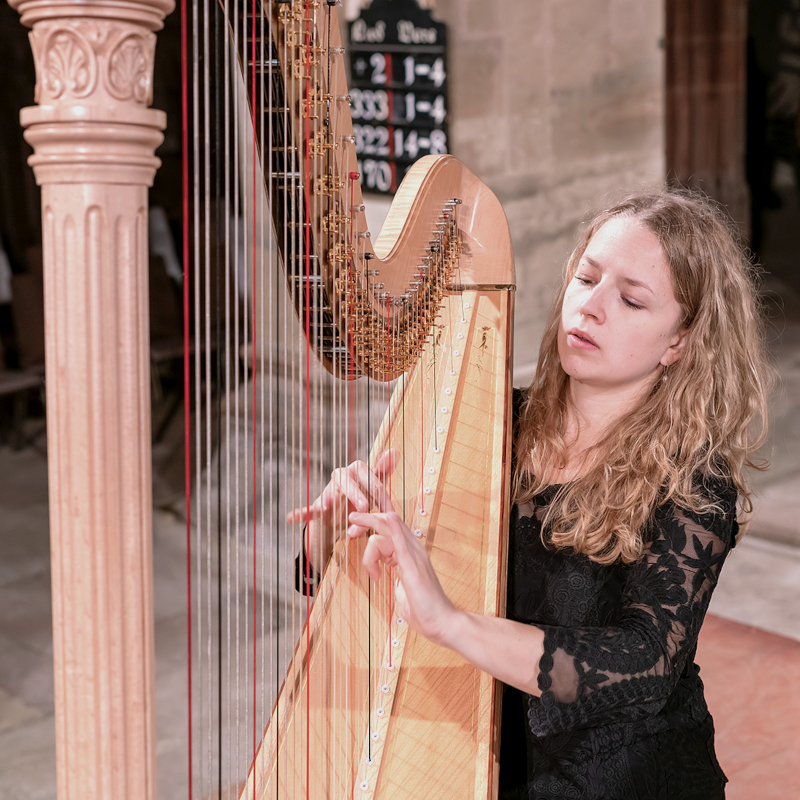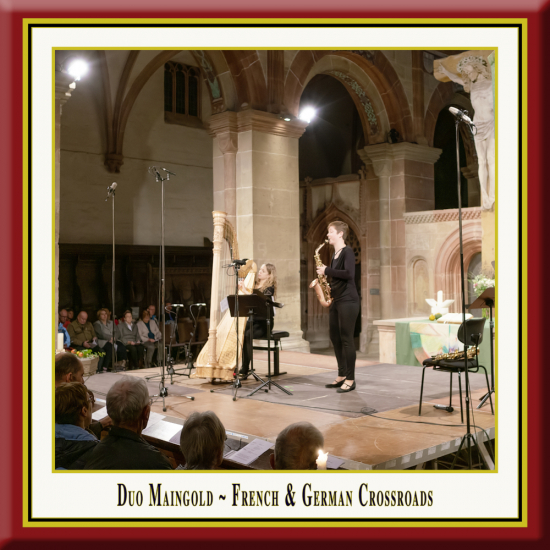Harp & Saxophone · French & German Crossroads
French & German Crossroads
A concert for Harp and Saxophone,
performed by Duo Maingold
Christina Bernard (Soprano & Alto Saxophone)
Lea Maria Löffler (Harp)
Compositions by Robert Schumann (1810-1856), Carl Philipp Emanuel Bach (1714-1788), Paul Bonneau (1918-1995), Claude Debussy (1862-1918), Gustav Bumcke (1876-1963), Ida Gotkovsky (*1933), Jacques de la Presle (1888-1969), Jacques Ibert (1890-1962) & Maurice Ravel (1875-1937)
A live recording from the church of the German UNESCO World Heritage Site Maulbronn Monastery
HD Recording · DDD · Duration: c. 68 Minutes
CD & Digital Music Album


I
n early December 1849, Robert Schumann composed in Dresden within five days the "Three Romances op. 94" in the original version for oboe and piano, which he gave to his wife Clara for Christmas as "his hundredth opusculum". The first performances were given by most renowned musicians: on 27 December 1849 in a home concert with the concertmaster of the Royal Chapel, François Schubert, and on 24 January 1850 with the composer and pianist Carl Reinecke in the Leipzig Gewandhaus. This quiet lyrical work is the starting point for further works in which Schumann experimented with freer forms and explored further sound options of the wind instruments in combination with a piano.
The "Sonata in G minor BWV 1020" has an eventful history. Shortly after its composition, it was first identified as a sonata for violin and keyboard instrument by Johann Sebastian Bach, but doubts about the old master's authorship arose as early as the time of Philipp Spitta. The style did not suit Bach, and a reliable copy in Vienna also mentions Carl Philipp Emanuel Bach as the composer. The attribution to the violin was also doubted, as there were no violin-specific effects. The whole style fitted much better to a flute. And although the sonata is now attributed to the Bach son Carl Philipp Emanuel, it nevertheless retains the ordinal number from the Bachwerkeverzeichnis. The first movement is characterized by harpsichord arpeggios, while the solo instrument quotes a theme from the great B minor flute sonata by father Johann Sebastian Bach. The second movement is pastoral, while the last movement comes along impetuously in the gesture of "Sturm und Drang".
The French conductor, arranger and composer Paul Bonneau (1918-1995) became known primarily through his film music and compositions in the field of entertainment music. He composed four works for saxophone solo, one of which is the "Caprice en forme Valse" in 1950. With typical French characteristics and difficult technical passages, it is a highly appreciated and varied piece for solo saxophone, in which large patches and small speckles of colour ignite a musical firework.
Claude Debussy loved the sea, where he found peace and quiet. He spent a lot of time in Cannes with his wife. And he was fascinated by the play with sounds. The "Rêverie" was probably composed between 1880 and 1884, and in a meditative character Debussy already creates a dreamlike atmosphere with a special sound, to which the gentle, repetitive theme contributes. The "Two Arabesques", written in 1888 and 1891, are two of Debussy's earliest impressionist pieces, in which the composer seems to change modes and keys frequently. Arabesque No. 2 is a fast, lively piece that also has echoes of the pentatonic.
Gustav Bumcke played a major role in establishing the saxophone in concert life. From his trip to Paris in 1902 he had brought back a whole set of saxophones to Berlin, where he subsequently founded various saxophone ensembles. He wrote more than 40 compositions for saxophone in all genres and a five-volume series of saxophone etudes. The "Notturno in E flat major op. 45" did not appear in print until 1992. The lyrical, aria-like melody in the saxophone, the flowing semiquaver motion of the harp and the limited length of the phrases pleasantly wrap up an etude to improve intonation and the ability to play in an ensemble.
Ida Gotkovsky's aim is to create universal works of art with her music, which in its characteristic contemporary language and energetic structures contributes to the unity of musical expression of all times. "Eolienne" was composed in 1970 for flute and harp. The five movements of the work are of very different character, like extremely different pictures, which together form a single, poetic work.
The composer and music educationalist Jacques de la Presle admired Fauré, Ravel, Debussy and Poulenc, while rejecting Wagner and Stravinsky. "Le jardin mouillé for harp" was composed in 1913, triggered by the poem "Le jardin mouillé" by Henri de Regnier about a rain-soaked garden, in which the visitor listens softly to the whispering of the drops and can perceive the different sounds of the drops on leaves, gravel or grass.
In contrast to Jacques de la Presle, Jacques Ibert was quite open to the music of a Stravinsky and musically can be located between neoclassicism and modernism. Ibert composed "Entr'acte" in 1937, a playful Caprice that is not committed to absolute music and belongs to the standard repertoire for harpists who love the lively piece in rondo form with a slight Spanish touch.

C
hristina Bernard, born in Erlangen in 1995, began her young studies at the age of 16 at the Hochschule für Musik Würzburg, where she has been continuing her studies with Lutz Koppetsch since 2013. She supplemented her education with master classes with Arno Bornkamp, Joonatan Rautiola, Jan Schulte-Bunert, Vincent David, Lars Mlekusch and Johannes Thorell, among others. Christina Bernard has won numerous prizes, including first federal prizes at the Jugend musiziert competition, third prize at the Berthold Hummel competition in Würzburg, first prize at the first J. Pakalnis International competition for Wind and Percussion Instrumentalists in Lithuania, first prize at the 23rd International Louis Spohr competition and first prize as well as sponsorship prizes at the competition for the Wolfgang Fischer and Maria Fischer-Flach prize. In 2018 she received a scholarship from the Deutscher Musikwettbewerb, combined with an acceptance into the 63rd Bundesauswahl-Konzerte for young artists. Christina Bernard is a scholarship holder of the Studienstiftung des deutschen Volkes, from Yehudi Menuhin "Live Music Now" and was supported by the Germany Scholarship. The saxophonist gained orchestral experience as a member of the National Youth Orchestra of Germany, the WDR Symphony Orchestra Cologne, the Essen Philharmonic, the Würzburg Philharmonic and the Thuringia Symphony Orchestra, among others. As a soloist, she has made guest appearances with the chamber orchestra in Bishkek in Kyrgyzstan and the ensemble orchestra of the National Philharmonic Society Musica Humana Juventus in Lithuania... www.christina-bernard.com

T
wenty-one year old Lea Maria Löffler began her musical education with the violin at the age of four. One year later she discovered her love for the harp. Her former teachers include Judith Geissler, Silke Aichhorn, Prof. Andreas Mildner and Prof. Mirjam Schröder. From 2008-2013 she studied in the pre-college at the University of Music in Würzburg and from 2013-2016 in the pre-college at the University of Music in Detmold, where she has been continuing her bachelor studies since 2016 under the tutelage of Godelieve Schrama. From 2018-2019 she studied in the class of Isabelle Moretti at the Conservatoire national supérieur de musique et de danse in Paris. In 2018, she won a scholarship at the Deutscher Musikwettbewerb and got admission to the Bundesauswahl Konzerte Junger Künstler (National Selection of Young Musical Artists), as well as the special prize of the Verband der Harfenisten in Deutschland. Lea Maria Löffler was a laureate of the International Franz Josef Reinl harp competition in 2018, the International Félix Godefroid harp competition in 2012, and the Verband der Harfenisten harp competition in 2010. She is supported by the Studienstiftung des deutschen Volkes since 2018, the Dr. Franz Stüsser Stiftung since 2017, and the Werner Richard - Dr. Carl Dörken Stiftung since 2015. In 2016 she was invited by the Werner Richard - Dr. Carl Dörken Stiftung to tour as part of the Best of NRW concert series and present solo recitals. Furthermore, she was awarded with the Conrad von der Goltz scholarship of the University of Music in Würzburg, and won special prizes of the Sparkassen NRW and the Hindemith Stiftung. As a harp soloist, Lea Maria Löffler has performed with renowned orchestras, such as the Würzburger Philharmoniker and the Bergische Symphoniker. She has also gained orchestral experience with orchestras such as the National Youth Orchestra of Germany. Regular solo appearances and concert tours have taken her to a wide variety of concert halls in Germany and abroad. Lea Maria Löffler appears on television and her concerts have been broadcasted by several national radio stations such as the BR (Bavarian Broadcasting), the WDR (Westgerman Broadcasting), and the Deutschlandfunk. Several CDs bear witness to her artistic work... www.lea-maria-loeffler.de
P
ublishing Authentic Classical Concerts entails for us capturing and recording outstanding performances and concerts for posterity. The performers, audience, opus and room enter into an intimate dialogue that in its form and expression, its atmosphere, is unique and unrepeatable. It is our aim, the philosophy of our house, to enable the listener to acutely experience every facet of this symbiosis, the intensity of the performance, so we record the concerts in direct 2-Track Stereo digital HD. The results are unparalleled interpretations of musical and literary works, simply - audiophile snapshots of permanent value. Flourishing culture, enthralling the audience and last but not least also you the listener, are the values we endeavor to document in our editions and series.
The concerts at the UNESCO World Heritage Maulbronn Monastery supply the ideal conditions for our aspirations. It is, above all, the atmosphere of the romantic, candle-lit arches, the magic of the monastery in its unadulterated sublime presence and tranquillity that impresses itself upon the performers and audience of these concerts. Renowned soloists and ensembles from the international arena repeatedly welcome the opportunity to appear here - enjoying the unparalleled acoustic and architectural beauty of this World Heritage Site, providing exquisite performances of secular and sacred music, documented by us in our Maulbronn Monastery Edition.
Andreas Otto Grimminger & Josef-Stefan Kindler, K&K Verlagsanstalt
Robert Schumann (1810-1856):
3 Romances for Oboe & Piano, Op. 94
Arranged for Soprano Saxophone & Harp by Duo Maingold
1. I. Nicht schnell [3:41]
2. II. Einfach, innig [4:02]
3. III. Nicht schnell [4:15]
Carl Philipp Emanuel Bach (1714-1788):
Sonata in G Minor for Violin & Piano, BWV 1020
Arranged for Soprano Saxophone & Harp by Duo Maingold
4. I. Allegro [4:06]
5. II. Adagio [2:44]
6. III. Allegro [3:57]
Paul Bonneau (1918-1995):
7. Caprice en forme de valse [5:31]
for Alto Saxophone Solo
Claude Debussy (1862-1918):
8. Rêverie for Piano [4:17]
9. Deuxième arabesque for Piano [4:02]
Arranged for Soprano Saxophone & Harp by Duo Maingold
Gustav Bumcke (1876-1963):
10. Notturno, Op. 45 [5:52]
for Alto Saxophone & Harp
Ida Gotkovsky (born 1933):
Eolienne for Alto Saxophone & Harp
11. I. Lyrique. Allegro agitato, tumultuoso [4:11]
12. II. Intermezzo. Nostalgique [1:07]
13. III. Intense. Lent. Molto espressivo [2:43]
14. IV. Perpetuum mobile. Prestissimo [2:52]
15. V. Declamatoire. Libre, large [1:32]
Jacques de la Presle (1888-1969):
16. Le jardin mouillé [6:28]
for Harp Solo
Jacques Ibert (1890-1962):
17. Entr'acte for Flute & Piano [3:18]
Arranged for Soprano Saxophone & Harp by Duo Maingold
Maurice Ravel (1875-1937):
Vocalise-Étude en forme de Habanera for Voice & Piano
Arranged for Alto Saxophone & Harp
18. Presque lent et avec indolence [2:55]
19. Applause [0:53]
A Live Recording to 'Direct-Stereo-Digital-HD' from the church of the German UNESCO World Heritage Site Maulbronn Monastery, documented, produced & released by Andreas Otto Grimminger & Josef-Stefan Kindler in cooperation with Sebastian Eberhardt (Maulbronn Monastery Concerts Organisation)
Concert Date: September 22, 2019
Sound Engineer: Andreas Otto Grimminger
Production & Mastering: Andreas Otto Grimminger & Josef-Stefan Kindler
Photography, Artwork & Coverdesign: Josef-Stefan Kindler

Featured by Spotify
This release is featured in the editorial playlist on Spotify:
CLASSICAL NEW RELEASES
Updated every Friday with the very best classical new releases





Featured by Spotify
20. March 2022 - 13:53 — kuk-art.comCLASSICAL NEW RELEASES
Updated every Friday with the very best classical new releases
https://open.spotify.com/playlist/37i9dQZF1DWV0gynK7G6pD
March 18, 2022